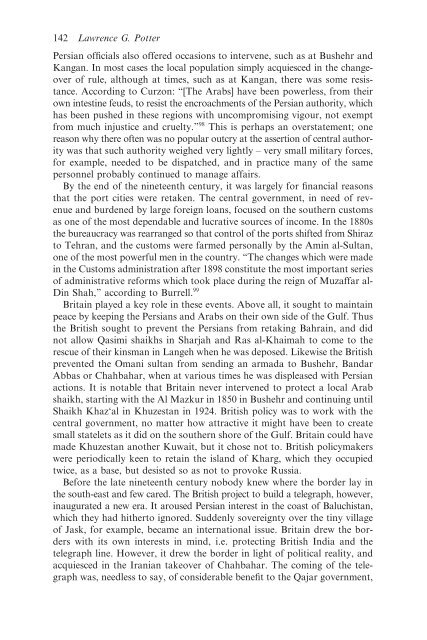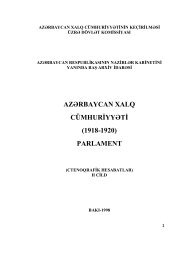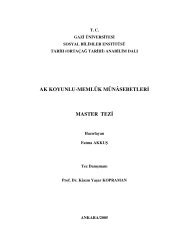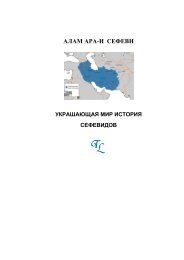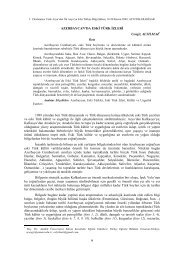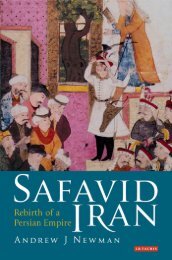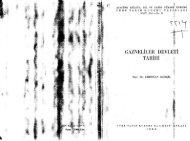War and Peace in Qajar Persia: Implications Past and ... - Oguzlar.az
War and Peace in Qajar Persia: Implications Past and ... - Oguzlar.az
War and Peace in Qajar Persia: Implications Past and ... - Oguzlar.az
- No tags were found...
You also want an ePaper? Increase the reach of your titles
YUMPU automatically turns print PDFs into web optimized ePapers that Google loves.
142 Lawrence G. Potter<strong>Persia</strong>n officials also offered occasions to <strong>in</strong>tervene, such as at Bushehr <strong>and</strong>Kangan. In most cases the local population simply acquiesced <strong>in</strong> the changeoverof rule, although at times, such as at Kangan, there was some resistance.Accord<strong>in</strong>g to Curzon: “[The Arabs] have been powerless, from theirown <strong>in</strong>test<strong>in</strong>e feuds, to resist the encroachments of the <strong>Persia</strong>n authority, whichhas been pushed <strong>in</strong> these regions with uncompromis<strong>in</strong>g vigour, not exemptfrom much <strong>in</strong>justice <strong>and</strong> cruelty.” 98 This is perhaps an overstatement; onereason why there often was no popular outcry at the assertion of central authoritywas that such authority weighed very lightly – very small military forces,for example, needed to be dispatched, <strong>and</strong> <strong>in</strong> practice many of the samepersonnel probably cont<strong>in</strong>ued to manage affairs.By the end of the n<strong>in</strong>eteenth century, it was largely for f<strong>in</strong>ancial reasonsthat the port cities were retaken. The central government, <strong>in</strong> need of revenue<strong>and</strong> burdened by large foreign loans, focused on the southern customsas one of the most dependable <strong>and</strong> lucrative sources of <strong>in</strong>come. In the 1880sthe bureaucracy was rearranged so that control of the ports shifted from Shir<strong>az</strong>to Tehran, <strong>and</strong> the customs were farmed personally by the Am<strong>in</strong> al-Sultan,one of the most powerful men <strong>in</strong> the country. “The changes which were made<strong>in</strong> the Customs adm<strong>in</strong>istration after 1898 constitute the most important seriesof adm<strong>in</strong>istrative reforms which took place dur<strong>in</strong>g the reign of Muzaffar al-D<strong>in</strong> Shah,” accord<strong>in</strong>g to Burrell. 99Brita<strong>in</strong> played a key role <strong>in</strong> these events. Above all, it sought to ma<strong>in</strong>ta<strong>in</strong>peace by keep<strong>in</strong>g the <strong>Persia</strong>ns <strong>and</strong> Arabs on their own side of the Gulf. Thusthe British sought to prevent the <strong>Persia</strong>ns from retak<strong>in</strong>g Bahra<strong>in</strong>, <strong>and</strong> didnot allow Qasimi shaikhs <strong>in</strong> Sharjah <strong>and</strong> Ras al-Khaimah to come to therescue of their k<strong>in</strong>sman <strong>in</strong> Langeh when he was deposed. Likewise the Britishprevented the Omani sultan from send<strong>in</strong>g an armada to Bushehr, B<strong>and</strong>arAbbas or Chahbahar, when at various times he was displeased with <strong>Persia</strong>nactions. It is notable that Brita<strong>in</strong> never <strong>in</strong>tervened to protect a local Arabshaikh, start<strong>in</strong>g with the Al M<strong>az</strong>kur <strong>in</strong> 1850 <strong>in</strong> Bushehr <strong>and</strong> cont<strong>in</strong>u<strong>in</strong>g untilShaikh Kh<strong>az</strong>‘al <strong>in</strong> Khuzestan <strong>in</strong> 1924. British policy was to work with thecentral government, no matter how attractive it might have been to createsmall statelets as it did on the southern shore of the Gulf. Brita<strong>in</strong> could havemade Khuzestan another Kuwait, but it chose not to. British policymakerswere periodically keen to reta<strong>in</strong> the isl<strong>and</strong> of Kharg, which they occupiedtwice, as a base, but desisted so as not to provoke Russia.Before the late n<strong>in</strong>eteenth century nobody knew where the border lay <strong>in</strong>the south-east <strong>and</strong> few cared. The British project to build a telegraph, however,<strong>in</strong>augurated a new era. It aroused <strong>Persia</strong>n <strong>in</strong>terest <strong>in</strong> the coast of Baluchistan,which they had hitherto ignored. Suddenly sovereignty over the t<strong>in</strong>y villageof Jask, for example, became an <strong>in</strong>ternational issue. Brita<strong>in</strong> drew the borderswith its own <strong>in</strong>terests <strong>in</strong> m<strong>in</strong>d, i.e. protect<strong>in</strong>g British India <strong>and</strong> thetelegraph l<strong>in</strong>e. However, it drew the border <strong>in</strong> light of political reality, <strong>and</strong>acquiesced <strong>in</strong> the Iranian takeover of Chahbahar. The com<strong>in</strong>g of the telegraphwas, needless to say, of considerable benefit to the <strong>Qajar</strong> government,


